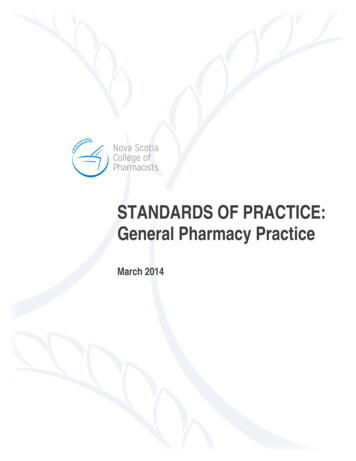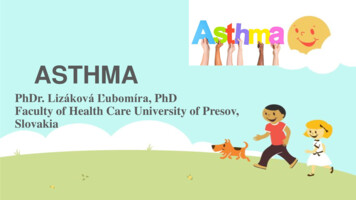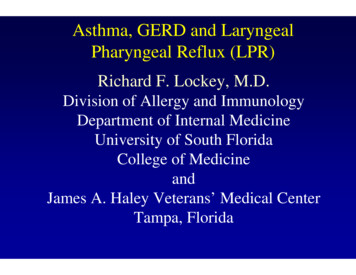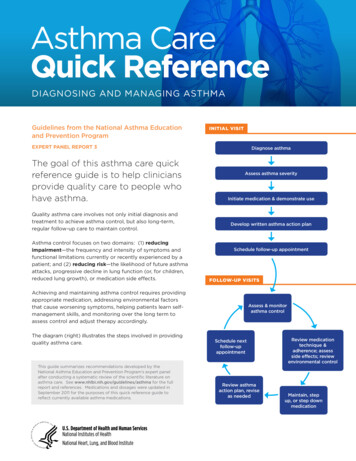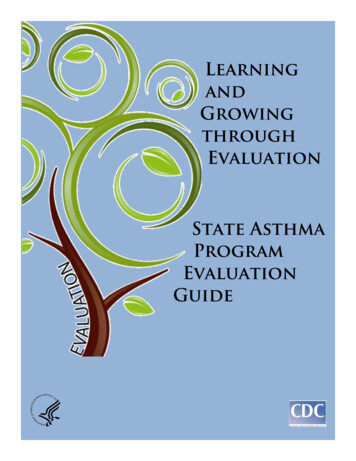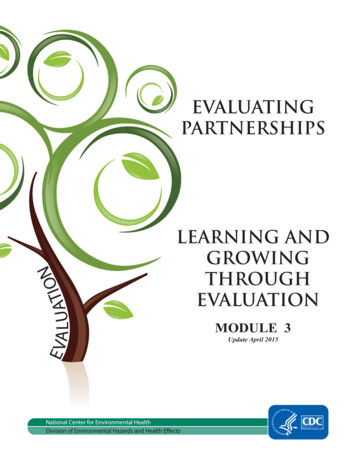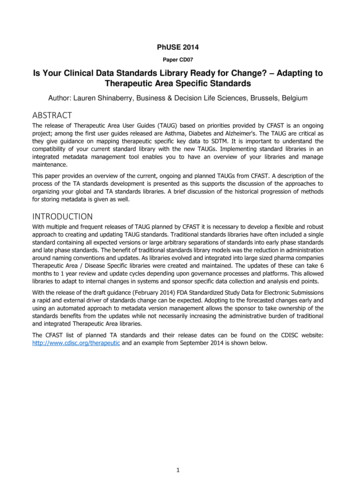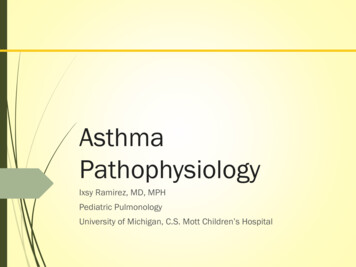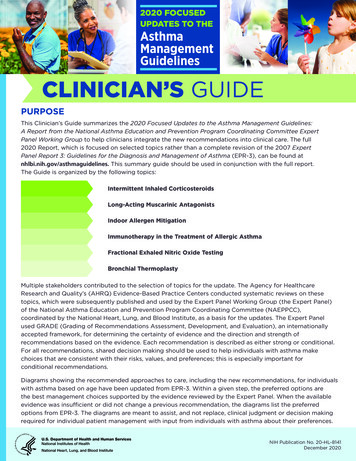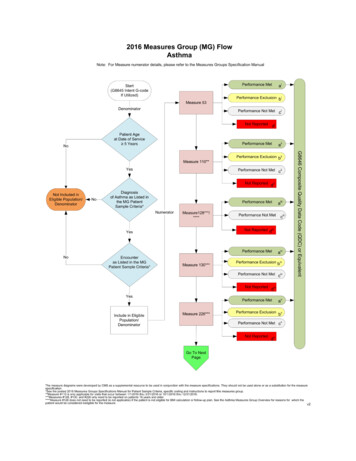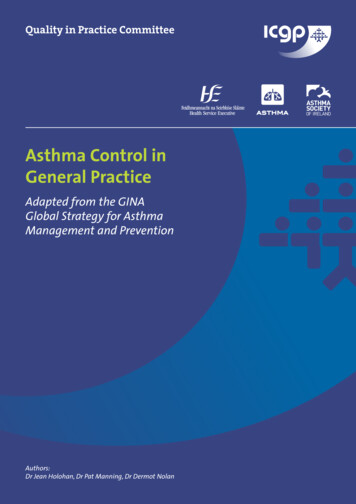
Transcription
Quality in Practice CommitteeAsthma Control inGeneral PracticeAdapted from the GINAGlobal Strategy for AsthmaManagement and PreventionAuthors:Dr Jean Holohan, Dr Pat Manning, Dr Dermot Nolan
Description of Levels of EvidenceEvidenceCategorySources of EvidenceARandomised controlled trials (RCTs). Rich body of dataBRandomised controlled trials (RCTs). Limited body of dataCNonrandomised trials. Observational studiesDPanel consensus judgement*Oxford Centre for Evidence-based Medicine levels of evidence (LOE)ICGP Quality in Practice Committee Members:Dr Paul Armstrong (Chair)Dr Sheena Finn,Dr Susan McLaughlinDr Grainne Ní Fhighlu,Dr Raymond O’Connor,Dr Maria O’Mahony,Dr Margaret O’Riordan,Dr Ben Parmeter,Dr William Ralph,Dr Philip Sheeran PurcellThe National Asthma Programme would like to acknowledge thework of Louis Coyne in developing these guidelines.This document’s content is adapted from the Global Initiativefor Asthma (GINA) 2012, 28/02/2012-last update, GINA Globalstrategy for asthma management and prevention. [Homepage ofGlobal lnitative for Asthma (GINA)], [Online]. Available: http://www.ginasthma.org/local/uploads/files/GINA Report 2012Feb13.pdf [2013, 01/02/2013].Disclaimer & Waiver of LiabilityWhilst every effort has been made by the Quality in Practice Committeeto ensure the accuracy of the information and material contained in thisdocument, errors or omissions may occur in the content.The guidance represents the view of the ICGP which was arrived at aftercareful consideration of the evidence available. Whilst we accept thatsome aspects of the recommendations may be difficult to implementinitially due to a lack of facilities or insufficient personnel, we stronglybelieve that these guidelines represent best practice. Where there aredifficulties these should be highlighted locally and elsewhere so thatmeasures are taken to ensure implementation. The guide does nothowever override the individual responsibility of healthcare professionalsto make decisions appropriate to the circumstances of individual patientsin consultation with the patient and/or guardian or carer.2nd Edition, ICGP 2013
Table of ContentsIntroductioniiClinical Diagnosis - Is it Asthma?1Asthma Management3Component 1: Develop Doctor/Patient PartnershipComponent 2: Identify and Reduce Exposure to Risk Factors35Component 3: Assess, Treat and Monitor Asthma6Step 2: As-needed reliever medication plus asingle controller7Step 1: As-needed reliever medicationStep 3: As-needed reliever medication plus oneor two controllersStep 4: As-needed reliever medication plus twoor more controllersStep 5: As-needed reliever medication plusadditional controller optionsComponent 4: Manage Asthma Exacerbations777710Management of Acute Adult Asthma inGeneral Practice Protocol11Management of Acute Asthma in Children 2–5 Years12Management of Acute Asthma in Children 6–15 Years13New Patient – Initial Visit Process Flow Diagram14Scheduled Review Process Flow Diagram15
QUALITY IN PRACTICE COMMITTEEAsthma Control in General PracticeAdapted from the GINA Global Strategy for Asthma Management and PreventionIntroductionAsthma is a chronic inflammatory condition of the airwayscharacterised by recurrent episodes of wheezing, breathlessness,chest tightness and coughing. Asthma cannot be prevented orcured but the clinical manifestations can be effectively controlledwith appropriate treatment. When asthma is controlled, thereshould be no more than occasional recurrence of symptoms andsevere exacerbations should be rare.Asthma in Ireland is characterised by high disease prevalence, suboptimal control in the majority of patients, low uptake of objectivelung function tests for diagnosis and management, infrequent useof asthma management plans and poor patient education.Ireland has the fourth highest prevalence of asthma world wide,affecting an estimated 450,000 people. Poor asthma control hassignificant health, social and economic costs. Patients bear themain burden of disease but the cost to our healthcare systemis significant. Recent data shows that acute exacerbations ofasthma result in over 5,000 hospital admissions, 20,000 EDattendances and 50,000 out-of-hours visits every year in Ireland.The estimated cost for hospital admissions and ED visits is inexcess of 18 million annually.At least one person dies from asthma every week in Ireland.The Global Initiative for Asthma (GINA) has a primary goal toproduce recommendations for the management of asthmabased on the best scientific information available. This revisedguideline is based on the 2011 update of the Global Strategyfor Asthma Management & Prevention and incorporates allthe clinically relevant updates since the first edition of ‘AsthmaControl in General Practice’ in 2008. The guideline providesrecommendations for the diagnosis and management of asthmain patients aged 5 years and older, in the primary care setting andis a core component of the National Asthma Programme.The scope of the National Asthma Programme is to ensurethe management of asthma is based on current internationalevidence-based care in all care settings including primary care.The aim of the Programme is to reduce morbidity and mortalityassociated with asthma in Ireland and to improve the quality oflife for all patients with asthma.The purpose of this document is to assist the healthcareprofessional to improve diagnostic accuracy; assess, treat andmonitor asthma; develop an asthma management plan forindividual patients; optimise asthma control; and to manageexacerbations in line with approved protocols. The widespreadimplementation of the tools outlined in the document will be asignificant factor in achieving this. This quality of care cannotbe fully implemented without the appropriate allocation ofresources to practices involved in its delivery.Dr Pat Manning, Dr Jean Holohan and Dr Dermot Nolanii ICGP 2013
QUALITY IN PRACTICE COMMITTEEAsthma Control in General PracticeAdapted from the GINA Global Strategy for Asthma Management and PreventionClinical Diagnosis: Is it Asthma?treatment is taken, when values are at their lowest and lastthing at night when values are usually higher.Medical HistoryA clinical diagnosis of asthma is often prompted by symptomssuch as episodic breathlessness, wheezing, cough, and chesttightness. Seasonal variability of symptoms and family historyof asthma/atopic disease are also helpful diagnostic guides andincrease the probability of a diagnosis of asthma as does theimprovement of symptoms after appropriate treatment. Thehistory is extremely important as asthma symptoms are variableand intermittent, and investigation may be completely normal.SymptomsMeasurement of airway responsivenessFor patients with symptoms consistent with asthma, but withnormal spirometry, measurements of airway responsivenessto methacholine, histamine, mannitol, or exercise challengemay help establish a diagnosis of asthma. These are generallyperformed in a pulmonary function facility.Physical examinationMeasurement of allergic statusMeasurement of allergic status (IgE, RAST, skin allergy tests)can help to identify risk factors that cause asthma symptomsin individual patients. The presence of allergies, eczema, andallergic rhinitis in particular, increase the probability of adiagnosis of asthma. Skin tests with allergens represent theprimary diagnostic tool in determining allergic status. Theyare simple and rapid to perform, have a low cost and highsensitivity. When performed incorrectly skin tests can lead tofalse positive or false negative results. Measurement of specificIgE in serum does not surpass the reliability of results from skintests and is more expensive.Asthma symptoms are variable; therefore physical examinationof the respiratory system may be normal. Wheezing onauscultation is the most common finding, but may only bedetected when the person exhales forcibly, even in the presenceof significant airway limitation.CodingIt is recommended that every patient is coded for asthma once adiagnosis has been confirmed. Asthma patients are coded underICD-10 as J45, and ICPC as R96.Tests for Diagnosis and MonitoringDiagnostic ChallengesThe classical symptoms are: Recurrent episodes of wheezing Troublesome cough at night Cough or wheeze after exercise Cough, wheeze or chest tightness after exposure toairborne allergens or pollutants Colds “go to the chest” or take more than 10 days to clearMeasurements of lung functionMeasurements of lung function (spirometry or peak expiratoryflow) provide an assessment of severity of airflow limitation, itsreversibility and its variability, and provide confirmation of thediagnosis of asthma.SpirometrySpirometry is recommended as the ideal method to establish adiagnosis of asthma. Reversibility (improvements in FEV1 within minutes afterinhalation of rapid-acting bronchodilator (e.g. after 200–400µg salbutamol 2–4 puffs) or sustained improvementover days/weeks after introduction of effective controllertreatment such as inhaled glucocorticosteroids). Thedegree of reversibility in FEV1 which indicates a diagnosisof asthma is accepted as 12% (or 200ml) from prebronchodilator value.Children 5 years and youngerThe diagnosis of asthma in early childhood is challenging andhas to be based largely on clinical judgment and an assessmentof symptoms and physical findings. Since the use of the label“asthma” for wheezing in children has important clinicalconsequences, it must be distinguished from other causes ofpersistent and recurrent wheeze.A useful method for confirming diagnosis of asthma in children5 years and younger is a trial of treatment with short-actingbronchodilators and inhaled glucocorticosteroids. Markedclinical improvement during the treatment and deteriorationwhen treatment is stopped supports a diagnosis of asthma.For full information and advice on asthma in this populationplease refer to the GINA Strategy for the Diagnosis andManagement of Asthma in Children 5 Years and Youngerwww.ginasthma.org. Variability (improvement or deterioration occurring overtime, day to day, month to month or seasonally). Obtaininga history of variability is an essential component of thediagnosis of asthma.Peak Expiratory Flow (PEF)1 A 60 L/min (or 20% of pre-bronchodilator PEF) improvementafter inhalation of a bronchodilator or a diurnal variation inPEF 20% suggests a diagnosis of asthma.PEF measurements can be an important aid in diagnosis andmonitoring of asthma but are not interchangeable with FEV1.PEF should be measured first thing in the morning, beforeExercise Induced Bronchoconstriction (EIB)Physical activity is an important cause of asthma symptomsfor most patients, and for some it is the only cause. EIB typicallydevelops 5–10 minutes after completing exercise (it rarelyoccurs during exercise). Patients experience typical asthmasymptoms, or sometimes a troublesome cough, which resolvespontaneously within 30–45 minutes. Some forms of exercise,such as running, are more potent triggers. EIB may occur in anyclimatic condition, but is more common when the patient isbreathing dry, cold air and less common in hot, humid climates ICGP 2013
QUALITY IN PRACTICE COMMITTEEAsthma Control in General PracticeAdapted from the GINA Global Strategy for Asthma Management and PreventionRapid improvement of post-exertion symptoms after inhaledβ2-agonists use, or their prevention by pre-treatment withinhaled β2-agonists before exercise, supports a diagnosis ofasthma. Some children with asthma present only with exerciseinduced symptoms. In this group, or where there is doubtabout the diagnosis, exercise testing is helpful. A StandardisedExercise Test to confirm suspicion of exercise induced asthmacan be performed and is usually carried out in pulmonaryfunction laboratory.The elderlyNew onset, undiagnosed asthma is a frequent cause oftreatable respiratory symptoms in the elderly. The presenceof co- morbid disease may complicate the diagnosis. Wheeze,breathlessness and cough are consistent with both asthmaand left ventricular failure. Use of beta-blockers, even topicallyfor glaucoma, is common in this age group. Poor perception ofsymptoms by patients, coupled with acceptance of dyspnoeaas being “normal” in older age, and reduced expectations ofmobility and activity can delay diagnosis. A careful historyand physical examination, combined with an ECG and chestX-ray, usually clarifies the picture. In the elderly, distinguishingasthma from COPD is particularly difficult, and may require atrial of treatment with bronchodilators and/or oral/inhaledglucocorticosteroids.Occupational asthmaDue to its insidious onset occupational asthma is oftenmisdiagnosed as chronic bronchitis or COPD. Development of newsymptoms of rhinitis, cough, and/or wheeze particularly in nonsmokers should raise suspicion.Probe: Work history and exposure History of occupational exposure to known or suspectedsensitising agents An absence of asthma symptoms before beginningemployment or A definite worsening of asthma after employmentcommenced Improvement of symptoms away from work/worsening ofsymptoms on returnMonitor PEF at least 4 times/day at work for 2 weeks andfor a similar period away from work. Since the managementof occupational asthma may require the patient to changeemployment, the diagnosis carries considerable socioeconomicimplications.Differentiation between COPD and Asthma*DiagnosisAsthmaCOPDSuggestive featuresOnset early in life (often childhood)Symptoms vary widely from day to daySymptoms worsen at night or morningAllergy, rhinitis and/or eczema presentFamily history of asthma Onset in mid-life Symptoms slowly progressive History of tobacco use or exposure to other typesof smoke* Global Initative for Chronic Obstructive Lung Disease (GOLD) 2013,20/02/2013-last update, Global strategy for the diagnosis, management andprevention of chronic obstructive pulmonary disease. [Homepage of GlobalInitative for Chronic Obstructive Lung Disease (GOLD)], [Onli
associated with asthma in Ireland and to improve the quality of life for all patients with asthma. The purpose of this document is to assist the healthcare professional to improve diagnostic accuracy; assess, treat and monitor asthma; develop an asthma management plan for individual patients; optimise asthma control; and to manage

